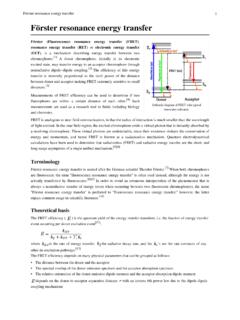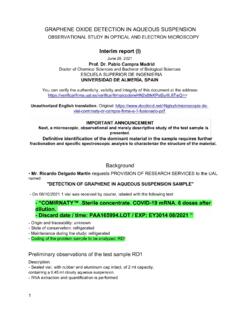Transcription of Fundamentals of Scanning Electron Microscopy and Energy ...
1 Fundamentals of Scanning Electron Microscopy and Energy Dispersive X-ray Analysis in SEM and TEMT amara Radeti ,University of BelgradeFaculty of Technology and Metallurgy, Beograd, SerbiaNFMC Spring School on Electron Microscopy , April 2011 Outline SEM Microscope features BSE SE X-ray EDS X-rays - origin & characteristics EDS system Qualitative & quantitative analysisNFMC Spring School on Electron Microscopy , April 2011 SEM: Basic Principles Electron source - gun Electron column- lenses- apertures- deflection coils Specimen chamber with detectorsNFMC Spring School on Electron Microscopy , April 2011 The scanned image is formed point by point in a serial fashion.
2 The scanned image is formed point by point in a serial fashion . microscope control console(electronics)SEM: Electron Gun Generates & accelerates electrons to an Energy range keV. Characteristics: Emission current, ie Brightness, E= angle=4ip/S2dp2Dp2 Source size Energy spread Beam stability Lifetime & costNFMC Spring School on Electron Microscopy , April 2011 SEM: Electron EmittersNFMC Spring School on Electron Microscopy , April 2011W- hairpinE=105A/cm2srds= 30-100 PmLaB6E=106A/cm2srds= 5-50 PmField emission - Cold- Thermal - SchottkyE=108A/cm2srds<5nmSEM: Electron LensesElectromagnetic lens defects: Spherical aberration: ds=1/2 CsD3 Chromatic aberration: dc= CcD('E/E0) Diffraction.
3 Dd= AstigmatismNFMC Spring School on Electron Microscopy , April 20111/f=1/p+1/qMagnification =M=q/pDemagnification=m=p/qSEM : working distance The working distance is defined as the distance between the lower pole piece of the objective lens and the plane at which the probe is Spring School on Electron Microscopy , April 2011 WorkingdistancePolepiecedetectorSample at ideal working distance for X-ray microanalysisSample at incorrect working distance for X-ray microanalysisSEM: Deflector (scan) Coils Magnification= Lspecimen/LCRTNFMC Spring School on Electron Microscopy , April 2011 Operator control of SEM LensesNFMC Spring School on Electron Microscopy , April 2011 Effect of aperture sizeEffect of condenser lens strengthEffect of working distancedp=(dG2+dS2+dd2+dC2)1/2dmin= KCs1/4l3/4(ip/EO2+1)3/8 SEM: Interaction Volume Monte Carlo simulationNFMC Spring School on Electron Microscopy , April 2011 Penetration depth: 1-5 PmSEM: Backscattered electrons K=nbse/nb=ibse/ib K(I)=KncosINFMC Spring School on Electron Microscopy , April 2011 BSEAl6(Fe,Mn)Mg2 SiSEM.
4 BSE Detectors Everhart-Thornley detector (with negative bias) Scintillator detector The solid state detectorNFMC Spring School on Electron Microscopy , April 2011 Electron beamto photomultiplierScintillator light pipeSolid angle of BSE detectorspecimenSEM: Secondary electronsNFMC Spring School on Electron Microscopy , April 2011 SE I - surface SE II - surface + volume SE III & IV - noiseSEM: SE detector Everhart-Thornley detector (with positive bias)NFMC Spring School on Electron Microscopy , April 2011 SEM: Other signalsNFMC Spring School on Electron Microscopy , April 2011 Generation of X-rays Characteristic X-rays photons Auger electrons Continuum X-rays or bremsstrahlungradiationNFMC Spring School on Electron Microscopy , April 2011 Incident e-beamEjected e-(SE)MLKC haracteristic X-rayEmissionContinuum X-rayEmissionnucleiElectron TransitionsNFMC Spring School on Electron Microscopy , April 2011 Families of Characteristic linesNFMC Spring School on Electron Microscopy , April 2011 EDS Spectra for Families of X-ray linesNFMC Spring School on Electron Microscopy , April 2011 EDS.
5 SEM - vs - STEM (TEM)NFMC Spring School on Electron Microscopy , April 2011 STEM (TEM) e beam Energy 100-400keV min probe size < 1nm specimen thickness <100 nmSEM e beam Energy min probe size > 1nm interaction volume ~ Pm The Energy of the incident Electron must be larger than ionization Energy for a given shell. U is overvoltage, U=E/EJ Optimal value of U 2 EDS: SEM - vs - STEM (TEM)NFMC Spring School on Electron Microscopy , April 2011 EDS User InterfaceNFMC Spring School on Electron Microscopy , April 2011 EDS SystemNFMC Spring School on Electron Microscopy , April 2011 Ele ment W eight % Ato mic %Si 2 ray Detector:Detects and converts X-rays into electronic signalsPulse processor:Measures the electronic signals of each X-ray :Displays & analyses.
6 Detector componentsNFMC Spring School on Electron Microscopy , April 2011 CryostatFETC rystal: Si(Li) Intrinsic GeWindow: Be UltrathinElectron trapCollimatorEDS: How the detector works?NFMC Spring School on Electron Microscopy , April 2011 creation of Electron /hole pair eV in average electronic noise & incoplete charge collection reduce Energy : Pulse detection and analysis Time constant, W- shorter W: higher count rate, but peak broadening (lower Energy resolution)- longer W: better resolution, but increase in dead time Dead time Dead time , %= (1-Rout/Rin)x100%NFMC Spring School on Electron Microscopy , April 2011 EDS: Energy resolution FWHM of MnKD, about 130eV Low Energy resolution: FWHM of F KD Low Energy resolution.
7 FWHM of C KDNFMC Spring School on Electron Microscopy , April 2011 FWHM2=kE+FWHM noise2 XEDS:ArtifactsSi escape peak bellow true characteristic peak positionNFMC Spring School on Electron Microscopy , April 2011 The internal fluorescencepeak A small Si KDpeak at sum peak too high count rateEDS: Qualitative Analysis Spectrum : peak identification Families of peaks Peak overlaps / deconvolution Artifacts & spurious peaks Background subtraction Count rate & collection time Limits: Probe size Spatial resolution Energy resolution Detectability limitNFMC Spring School on Electron Microscopy , April 2011 Profile (line spectrum)EDS: Qualitative AnalysisNFMC Spring School on Electron Microscopy , April 2011 Elemental mappingAlSiTi Acqusition under best conditions Flat specimen, avoid coating, homogeneous specimen (at list in the analysis/interaction volume) High count rate, but optimum dead time Optimum overvoltage Standards : ci/cstd=Ii/Istd=ki Matrix correction ZAF Z : effect of R & S A : absorption F.
8 Secondary fluorosence Recalculate concentrations Other corrections: PROZA, PaP, XPP Standardless analysisEDS: Quantitative Analysis for SEMNFMC Spring School on Electron Microscopy , April 2011CA/CB= IBCA,B- concentration in wt%IA,B- peak intensityKAB- Cliff-Lorimer factorkAB= kAR/ kBRkAR= AAwRQBaReR/ ARwAQAaAeAA = atomic weight w = fluorescent yieldQ = ionisation cross sectiona = the fraction of the total line, K / (K +K ) for a Ka linee = the absorption due to the detector window at that line : Quantitative Analysis for TEMNFMC Spring School on Electron Microscopy , April 2011 Typical k ASi curve for K lines for a Be window detector (after P.)
9 J. Sheridan [1989] )NFMC Spring School on Electron Microscopy , April 2011 SEM - EDS - TEMSEM - EDS - TEMSTATE Grain size, m Al6(Fe,Mn) area fraction, % Al-Mg-Si based particles, area fraction, % Precipitates free zone s width, mAs-cast 384 24 1-stage homogenization 2-stage homogenization 549 50 3-stage homogenization 566 50 TEM Specimen Preparation in Materials ScienceTamara RadeticDept.
10 Metall. Eng., Faculty of Technology & Metallurgy,University of Belgrade, SerbiaNFMC Spring School on Electron Microscopy , April 2011 Why is the specimen preparation that important?No good specimen - No good TEM! Microscopic - vs - macroscopic No simple rules for various materials & purposes Artifacts Arts -vs- Science ?NFMC Spring School on Electron Microscopy , April 2011 Basic requirements Representative of the material under investigation Artifact free Clean, without contamination Mechanically rigid and stable Resistant to the Electron beam irradiation Electrically conductive Large area transparent to the Electron beamNFMC Spring School on Electron Microscopy , April 2011 Principals for a TEM specimen preparation Safety Time-effective Cost-effective RepeatableNFMC Spring School on Electron Microscopy , April 2011 Size of a TEM specimen Diameter: 3mm, or even 1mm!







